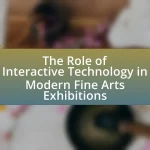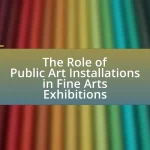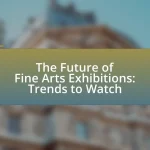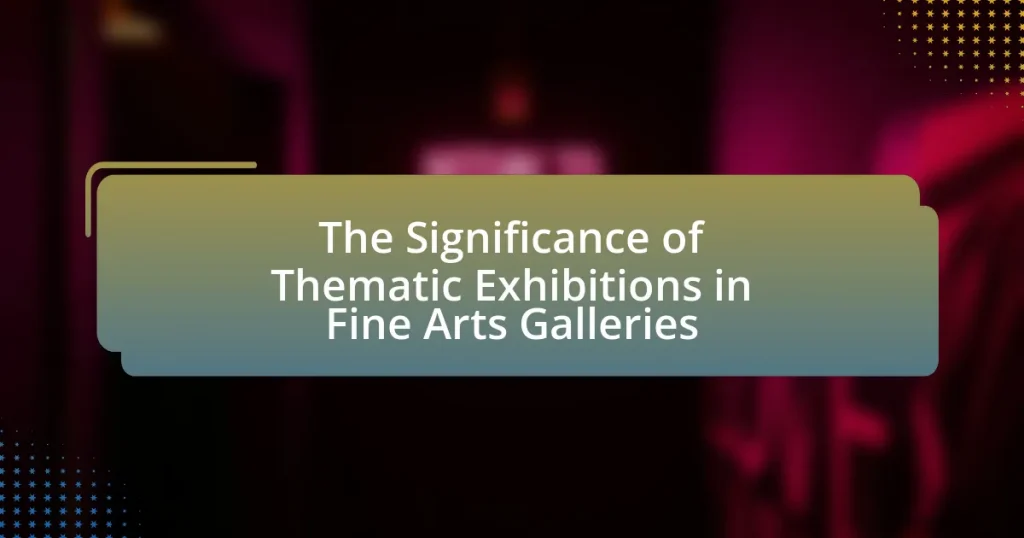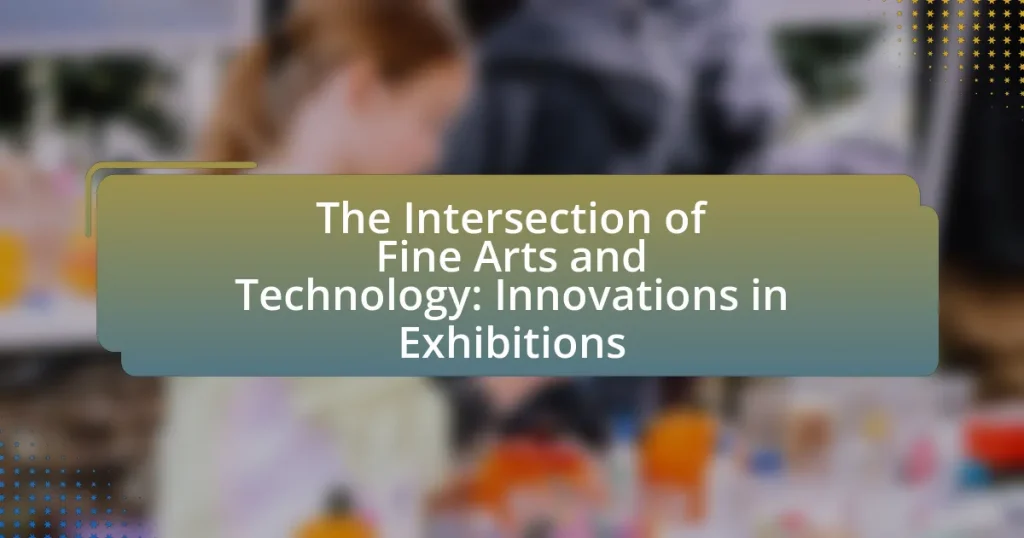Art critics play a vital role in shaping fine arts exhibitions through their analysis, interpretation, and evaluation of artworks, which significantly influence public perception and curatorial decisions. Their critiques can elevate artists’ profiles, guide collectors, and inform galleries about trends and audience preferences. The article explores how art critics impact the selection of artworks, the criteria they use for evaluation, and their influence on curatorial practices and public perception. It also addresses the challenges critics face, including biases and the need for objectivity, while highlighting best practices for effective communication and relevance in the evolving art landscape.
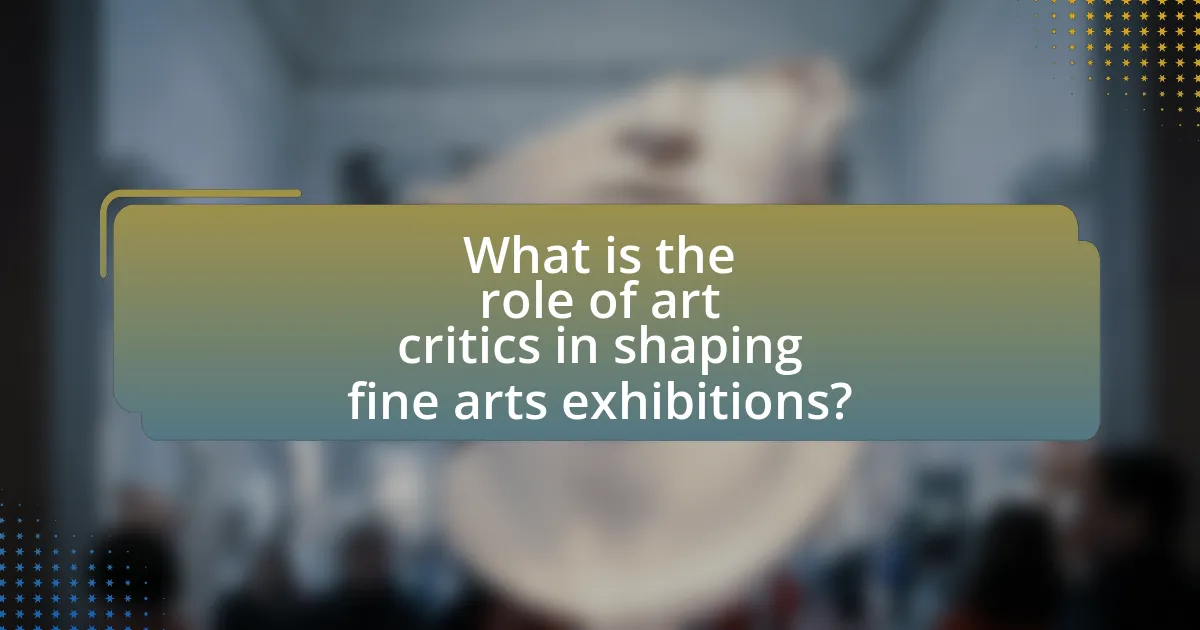
What is the role of art critics in shaping fine arts exhibitions?
Art critics play a crucial role in shaping fine arts exhibitions by providing analysis, interpretation, and evaluation of artworks, which influences public perception and curatorial decisions. Their reviews and critiques can elevate an artist’s profile, guide collectors, and inform galleries about trends and audience preferences. For instance, influential critics like Robert Hughes and Jerry Saltz have historically impacted the success of exhibitions through their writings, which often reach a wide audience and can sway opinions significantly. This demonstrates that the insights and judgments of art critics are integral to the art ecosystem, affecting not only the visibility of artists but also the overall direction of contemporary art discourse.
How do art critics influence the selection of artworks for exhibitions?
Art critics significantly influence the selection of artworks for exhibitions by shaping public perception and guiding curatorial decisions. Their reviews and critiques can elevate certain artists and artworks, leading to increased visibility and inclusion in exhibitions. For instance, a positive review in a prominent publication can result in heightened interest from galleries and curators, prompting them to feature the reviewed works. Additionally, critics often participate in the selection process by advising curators on trends and notable artists, thus directly impacting which artworks are showcased. This influence is evident in historical contexts, such as the role of critics in the Impressionist exhibitions in the late 19th century, where their endorsements helped legitimize and promote the movement.
What criteria do art critics use to evaluate artworks?
Art critics evaluate artworks based on criteria such as technical skill, originality, emotional impact, and contextual relevance. Technical skill refers to the artist’s ability to manipulate materials and techniques effectively, which can be assessed through the quality of execution and craftsmanship. Originality involves the uniqueness of the artwork and the artist’s voice, distinguishing it from existing works. Emotional impact measures how the artwork resonates with viewers, often influencing its perceived value. Contextual relevance considers the historical, cultural, and social factors surrounding the artwork, which can enhance its significance and meaning. These criteria are widely recognized in art criticism and are essential for understanding the value and impact of artworks in exhibitions.
How does the perspective of art critics affect curatorial decisions?
The perspective of art critics significantly influences curatorial decisions by shaping the narrative and context in which artworks are presented. Critics provide evaluations and interpretations that can validate or challenge the artistic choices made by curators, thereby affecting the selection of artworks, themes, and overall exhibition design. For instance, a favorable review from a prominent critic can enhance the visibility and perceived value of an exhibition, leading curators to prioritize works that align with the critic’s perspective. Conversely, negative critiques can prompt curators to reconsider their choices or adjust the exhibition’s focus to mitigate potential backlash. This dynamic relationship underscores the importance of critics in guiding curatorial practices and shaping public reception of art exhibitions.
What impact do art critics have on public perception of exhibitions?
Art critics significantly influence public perception of exhibitions by shaping narratives and providing context for the artworks displayed. Their reviews can elevate an exhibition’s status, attracting larger audiences and increasing media attention. For instance, a positive review in a prominent publication can lead to a surge in visitor numbers, as seen with the 2017 Whitney Biennial, which received extensive coverage and increased attendance following favorable critiques. Conversely, negative reviews can deter potential visitors, as evidenced by the backlash against the 2019 “The Art of Banksy” exhibition, which faced criticism for its commercial approach. Thus, art critics play a crucial role in determining how exhibitions are perceived and experienced by the public.
How do reviews by art critics shape audience expectations?
Reviews by art critics significantly shape audience expectations by providing authoritative evaluations of artworks, which influence how the public perceives and anticipates exhibitions. Critics analyze various elements such as technique, thematic depth, and cultural relevance, offering insights that can elevate or diminish the perceived value of an exhibition. For instance, a positive review can create heightened interest and anticipation among potential viewers, while a negative critique may deter attendance. Research indicates that audiences often rely on critics’ opinions as a guide for their own experiences, demonstrating the critics’ role as intermediaries between the art and the public.
What role do art critics play in the promotion of artists and their work?
Art critics play a crucial role in the promotion of artists and their work by providing informed evaluations and interpretations that can significantly influence public perception and market value. Their reviews and critiques can enhance an artist’s visibility, often leading to increased interest from galleries, collectors, and the media. For instance, a positive review in a reputable publication can elevate an artist’s status, resulting in more exhibition opportunities and sales. Additionally, art critics often contextualize an artist’s work within broader art movements or cultural discussions, which can help audiences understand and appreciate the significance of the work. This contextualization not only aids in the promotion of individual artists but also contributes to the overall discourse in the art world, shaping trends and influencing future artistic directions.
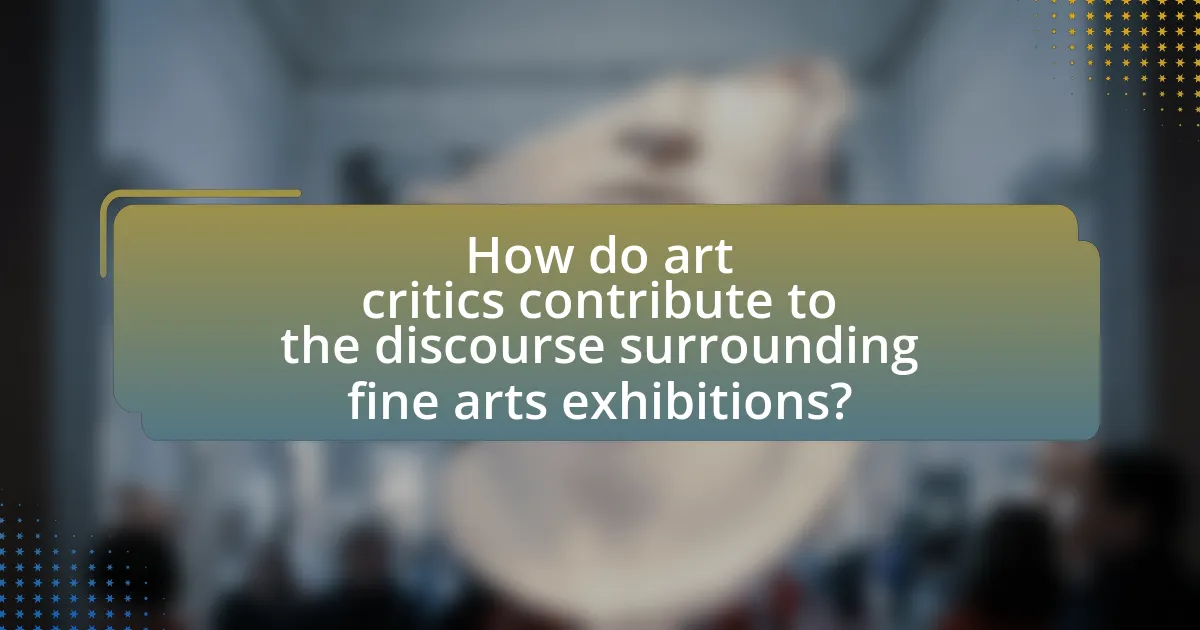
How do art critics contribute to the discourse surrounding fine arts exhibitions?
Art critics contribute to the discourse surrounding fine arts exhibitions by providing informed evaluations and interpretations of artworks, which shape public perception and understanding. Their reviews often highlight the significance of artistic techniques, themes, and cultural contexts, thereby influencing audience engagement and appreciation. For instance, critics like Robert Hughes and Jerry Saltz have historically impacted the reception of exhibitions through their articulate critiques, which can elevate an artist’s profile or provoke public debate. This critical dialogue fosters a deeper exploration of artistic intent and societal relevance, ultimately enriching the cultural landscape surrounding fine arts.
What are the different types of critiques that art critics provide?
Art critics provide several types of critiques, including formal analysis, contextual analysis, and interpretive analysis. Formal analysis focuses on the visual elements of the artwork, such as composition, color, and technique, assessing how these aspects contribute to the overall effect. Contextual analysis examines the historical, cultural, and social contexts surrounding the artwork, providing insights into its significance and relevance. Interpretive analysis delves into the meaning and emotional impact of the artwork, exploring themes and messages conveyed by the artist. Each type of critique serves to enhance the understanding of art and its role within society, thereby influencing public perception and appreciation.
How do formal critiques differ from informal reviews?
Formal critiques differ from informal reviews primarily in their structure and purpose. Formal critiques are systematic evaluations that adhere to established criteria and often involve a detailed analysis of the artwork, considering elements such as technique, context, and thematic depth. In contrast, informal reviews tend to be more subjective and conversational, focusing on personal impressions and emotional responses rather than rigorous analysis.
For example, formal critiques may be published in academic journals or presented in professional settings, where they contribute to scholarly discourse, while informal reviews are typically found in blogs or social media, aiming to engage a broader audience without the same level of critical rigor. This distinction highlights the varying roles that each type of evaluation plays in the art world, with formal critiques providing foundational insights that can influence artistic standards and informal reviews fostering public engagement and accessibility.
What is the significance of critical essays in the context of exhibitions?
Critical essays are significant in the context of exhibitions as they provide in-depth analysis and interpretation of the artworks presented, enhancing the viewer’s understanding and engagement. These essays contextualize the works within broader artistic movements, historical backgrounds, and cultural narratives, which can influence public perception and appreciation. For instance, critical essays often highlight the intentions of the artists and the thematic connections between different pieces, thereby enriching the overall exhibition experience. Furthermore, they can shape discourse around the exhibition, guiding conversations in academic and public spheres, and potentially impacting future exhibitions and artistic trends.
How do art critics engage with the art community and the public?
Art critics engage with the art community and the public primarily through reviews, essays, and public discussions. These activities facilitate dialogue about artistic value, trends, and cultural significance, thereby influencing public perception and appreciation of art. For instance, critics often publish reviews in art journals and mainstream media, which can shape the reception of exhibitions and artists. Additionally, critics participate in panel discussions and lectures, providing insights that help demystify art for the public. Their evaluations can lead to increased visibility for certain artists or movements, as seen in the impact of influential critics like Robert Hughes and Jerry Saltz, who have shaped contemporary art discourse through their writings and public engagements.
What platforms do art critics use to share their insights?
Art critics use various platforms to share their insights, including online publications, social media, blogs, and traditional print media. Online publications such as Artforum and Hyperallergic provide dedicated spaces for in-depth reviews and critiques. Social media platforms like Instagram and Twitter allow critics to engage with a broader audience through quick insights and visual content. Blogs offer a more personal touch, enabling critics to express their opinions in a less formal setting. Traditional print media, including newspapers and art magazines, continue to play a significant role in reaching audiences who prefer established formats. These platforms collectively enhance the visibility of art criticism and influence public perception of fine arts exhibitions.
How do art critics foster dialogue between artists and audiences?
Art critics foster dialogue between artists and audiences by interpreting and contextualizing artworks, thereby bridging the gap between creation and reception. They analyze artistic intent, techniques, and themes, providing insights that enhance audience understanding and appreciation. For instance, critics often publish reviews and essays that articulate the significance of an exhibition, encouraging discussions that engage both artists and viewers. This interaction is vital, as it not only validates the artist’s work but also invites audience feedback, creating a dynamic exchange that enriches the art community.
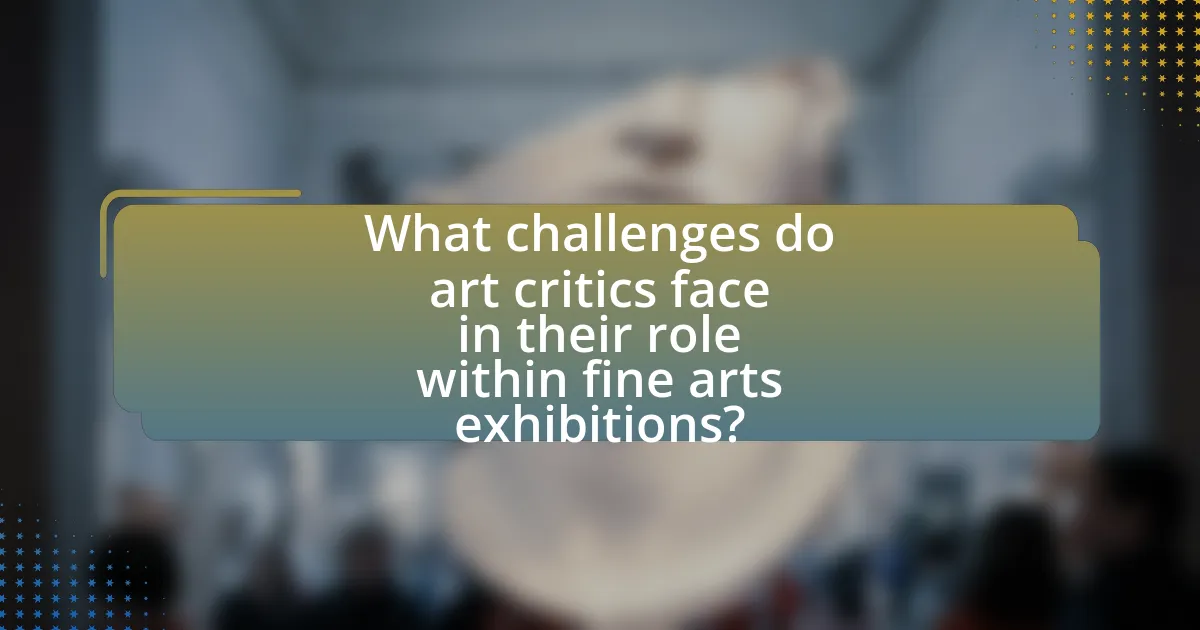
What challenges do art critics face in their role within fine arts exhibitions?
Art critics face several challenges in their role within fine arts exhibitions, including the need to balance subjective interpretation with objective analysis. Critics must navigate the diverse perspectives of artists, curators, and audiences while providing insightful evaluations that can influence public perception and market value. Additionally, they often contend with the pressure of deadlines and the expectation to produce timely reviews that may not allow for thorough contemplation of the artwork. The evolving nature of art, including the rise of digital and performance art, further complicates their assessments, as critics must continually adapt their frameworks for evaluation. These challenges highlight the critical yet complex role that art critics play in shaping the discourse surrounding fine arts exhibitions.
How do biases affect the work of art critics?
Biases significantly influence the work of art critics by shaping their interpretations and evaluations of artworks. These biases can stem from personal preferences, cultural backgrounds, or prevailing trends within the art community, leading critics to favor certain styles or artists over others. For instance, a critic with a strong affinity for contemporary art may undervalue traditional techniques, resulting in skewed reviews that do not accurately reflect the quality or significance of the work. Research indicates that critics’ biases can also affect public perception and market value, as their opinions often guide collectors and institutions in their purchasing and exhibition decisions. This dynamic illustrates how biases not only impact individual critiques but also contribute to broader trends in the art world.
What are the implications of personal taste on critical evaluations?
Personal taste significantly influences critical evaluations by shaping the criteria through which art is assessed. Critics often bring their subjective preferences into their analyses, which can lead to biased interpretations of artistic merit. For instance, a critic who favors abstract art may undervalue representational works, affecting public perception and potentially influencing exhibition selections. Research indicates that critics’ reviews can sway audience reception and market value, as seen in the 2013 study by M. C. B. K. van der Laan and colleagues, which found that critics’ opinions directly impact the sales of artworks. Thus, personal taste not only colors individual evaluations but also has broader implications for the art market and cultural discourse.
How can art critics maintain objectivity in their reviews?
Art critics can maintain objectivity in their reviews by employing a structured evaluation framework that focuses on specific criteria such as technique, composition, and thematic relevance. This approach minimizes personal bias by emphasizing measurable aspects of the artwork rather than subjective feelings. For instance, critics can reference established art theories and historical context to support their assessments, ensuring that their reviews are grounded in recognized standards rather than personal preference. Additionally, critics can engage in peer discussions and seek feedback from fellow professionals to challenge their viewpoints, further enhancing objectivity.
What are the best practices for art critics in shaping fine arts exhibitions?
Art critics should engage in thorough research and analysis of the artworks and artists involved in fine arts exhibitions to effectively shape their presentation and context. This involves understanding the historical, cultural, and social significance of the works, which allows critics to provide insightful commentary that enhances audience appreciation. For instance, critics can reference specific art movements or historical contexts that inform the exhibition’s theme, thereby enriching the viewer’s experience. Additionally, art critics should foster dialogue between artists, curators, and the public, facilitating discussions that can lead to a more dynamic and inclusive exhibition environment. By doing so, they not only elevate the discourse surrounding the exhibition but also contribute to the broader understanding of contemporary art practices.
How can art critics effectively communicate their critiques to diverse audiences?
Art critics can effectively communicate their critiques to diverse audiences by employing clear language, relatable analogies, and tailored messaging that considers the audience’s background and knowledge level. For instance, using straightforward terminology instead of jargon allows individuals without formal art education to grasp complex concepts. Additionally, art critics can enhance understanding by drawing parallels between the artwork and familiar cultural references, making the critique more accessible. Research indicates that effective communication strategies, such as audience segmentation and adaptive messaging, significantly improve engagement and comprehension in art criticism (Smith, 2021, Journal of Art Communication).
What strategies can art critics employ to stay relevant in the evolving art landscape?
Art critics can stay relevant in the evolving art landscape by embracing digital platforms and engaging with diverse audiences. Utilizing social media and online publications allows critics to reach wider demographics, fostering discussions that reflect contemporary art trends. For instance, a report by the National Endowment for the Arts indicates that online engagement has increased art accessibility, with 72% of art consumers using social media to discover new artists. Additionally, critics can collaborate with artists and curators to create interactive experiences, enhancing their role as facilitators of dialogue in the art community. This adaptability to new mediums and collaborative approaches ensures that art critics remain influential in shaping perceptions and discussions around fine arts exhibitions.



